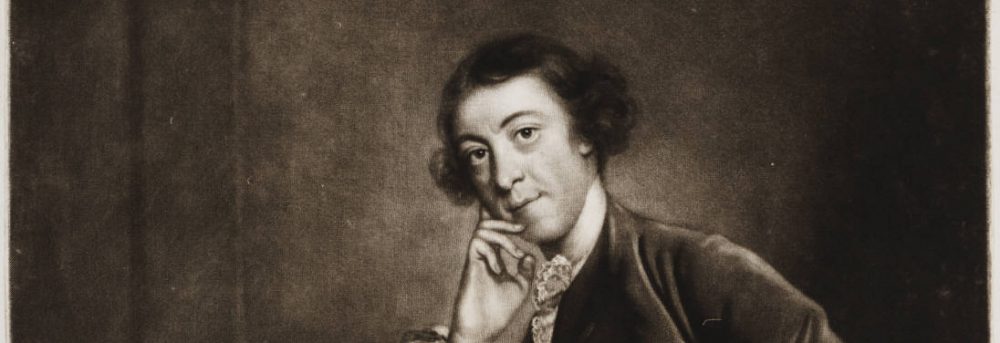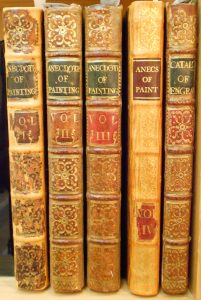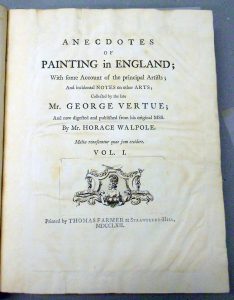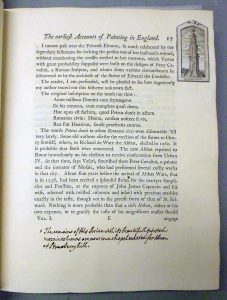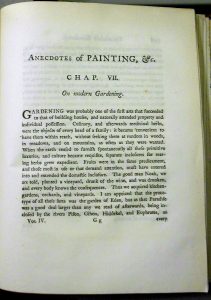17.Choice 10: Walpole’s Copy of Anecdotes of Painting in England, 4 vols., Strawberry Hill 1762-71
By Wilmarth S. Lewis
“This, the most ambitious of Walpole’s works, was based on forty notebooks compiled by George Vertue, the engraver and antiquary (1684-1756), with a view to writing the first history of painting in England. Walpole records in ‘Short Notes’ and the ‘Journal of the Printing Office’ that he bought Vertue’s notebooks and drawings from Vertue’s widow in 1758 for £100 and that in 1759 he ‘began to look over the notebooks in order to compose the lives of English painters.’ The result was Anecdotes of Painting in England, with some Account of the principal Artists; And incidental Notes on other Arts; Collected by the late Mr George Vertue; And now digested and published from his original MSS, by Mr Horace Walpole, 4 vols. 1762-71. ‘Mr’ was no longer ‘a Gothic abomination’ as it was in Choice 5.
“Walpole’s Preface states that owing to the paucity of native-born geniuses, England ‘has not a single volume to show on the works of its painters. This very circumstance may with reason prejudice the reader against a work, the chief business of which must be to celebrate the arts of a country which has produced so few good artists. This objection is so striking, that instead of calling it The Lives of English Painters, I have simply given it the title of Anecdotes of Painting in England. The indefatigable pains of Mr. Vertue left nothing unexplored that could illuminate his subject, and collaterally led him to many particularities that are at least amusing: I call them no more, nor would I advise any man, who is not fond of curious trifles to take the pains of turning over these leaves.’ Walpole brought his work down to the end of George II’s reign in 1760. He included ‘other arts,’ ‘Statuaries, Carvers, Architects, and Medallists,’ and closed with an ‘Essay on Modern Gardening.’
“Over thirty of Vertue’s notebooks have been printed verb. et lit. by the English Walpole Society from the originals, which are now mostly in the British Library. The originals show that Walpole’s description of them, ‘indigested’ and ‘unreadable,’ is charitable–‘chaotic’ and ‘illiterate’ would not be unjust. The Anecdotes show that Walpole was a superb editor who brought order and style out of Vertue’s incoherence.”
Lewis uses Rembrandt as an example and quotes from both Vertue’s notebooks and Walpole’s subsequent footnote appearing in the Anecdotes.
Lewis continues, “Besides making Vertue’s notes readable, Walpole added much new material and closed the gaps in Vertue’s account. ‘From the reign of Henry III Mr Vertue could discover no records relating to the arts for several reigns,’ Walpole wrote. ‘I shall endeavour to fill this hiatus by producing an almost entire chronologic series of paintings from that time to Henry VII when Mr Vertue’s notes recommence,’ and he did so in twenty-one pages.
“The first two volumes of the Anecdotes appeared in 1762, the third volume and Catalogue of Engravers in 1763; the fourth volume was printed in 1771, but was held up until 1780 because Walpole didn’t want to offend Hogarth’s widow by his strictures on the artist’s ‘Sigismonda.’ (We shall come to ‘Sigismonda’ and Mrs Hogarth in Choice 23.) All five volumes were reprinted in 1825 and 1849. I hope one day that the Lewis Walpole Library will publish another edition that will make clear the contributions of both Vertue and Walpole to their pioneer history of painting in England.”
Lewis discusses Walpole’s visits to and notes about country houses, his Aedes Walpolianae catalog of his father’s collection at Houghton, and his interest in art exhibitions. Lewis then recounts his own acquisition of Walpole’s copy of the first edition of the Anecdotes from the collection at Knowsley, his interactions with the Librarian there, and the many other Walpolian items he purchased at the sales of Lord Derby’s library.
“The fourth volume of the Anecdotes ends, as I have said, with Walpole’s essay ‘On Modern Gardening.’ It is another pioneer work that was reprinted in 1975 for the tenth time. The Walpole Printing Office of Mount Vernon, New York, brought out an edition of it in 1931 for Young Books, Inc., of New York for which my wife wrote a bibliography and I wrote a Preface. I explained the appearance of the ‘Essay on Modern Gardening’ in the Anecdotes by quoting Pope’s dictum, ‘Gardening is painting.’ To Walpole and his contemporaries gardening was no longer formal beds of herbs or ‘giants, animals, coats of arms and mottoes in yew, box and holly,’ but a large-scale enterprise that dealt with landscape. Woods and rocks and water were needed to ‘improve the view’ and create the ‘romantic’ garden on a scale commensurate with the owner’s magnificence.
“Modern taste, Walpole pointed out, dawned with Charles Bridgman, George II’s gardener, whose innovations included the destruction of walls for boundaries and the substitution of sunken ditches ‘that the common people called “Ha! Ha’s!”‘ Bridgman was followed by William Kent who, Walpole wrote, was ‘painter enough to taste the charms of landscape. . . . He leaped the fence and saw that all nature was a garden.’ The influence of the painters, especially Claude, Gaspart Poussin, and Salvator Rosa, was strong. ‘If we have the seed of a Claude or Gaspar amongst us,’ Walpole wrote, ‘he must come forth. If wood, water, groves, alleys, glades, can inspire poet or painter, this is the country, this is the age to inspire them.’ Walpole’s patriotism extended to England’s rocks and rills.
“The Journal of the Printing Office records that in 1785 the Press began to print the translation by the duc de Nivernais of Walpole’s ‘Essay on Modern Gardening’ in an edition of 400 copies, half of which were sent to the duke.”
Lewis concludes his Choice 10 with a quote from a note of gratitude written by a Richmond neighbor of Walpole’s for the gift of a different copy of the Anecdotes. The note ends this flattering assessment of Walpole: “‘His natural talents, his cheerfullness, the sallies of his imagination, the liveliness of his manner, the unexpected impression on the ear of those who hear and listen to him, comes on, like a shooting star, or, like Uriel, gliding on a sun beam. I never met him, but with pleasure, and never left him but with regret.'”
Lewis, Wilmarth S. Rescuing Horace Walpole. New Haven and London: Yale University Press, 1978.
To see the full chapter from Rescuing Horace Walpole called Choice 10: Walpole’s Copy of Anecdotes of Painting in England, 4 vols., Strawberry Hill 1762-71 download or expand the link here:
 Loading...
Loading...
N.B. The copy discussed in this blog post is call number 49 2519 at the Lewis Walpole Library. It is extra-illustrated and has Walpole’s manuscript notes. Hazen explains the late appearance of volume 4, published some eleven years after the Catalogue of Engravers: “This final volume had been planned at least as early as 1763, since the Direction to the binder in the Catalogue of Engravers reads: ‘This volume should not be lettered as the fourth, but as a detached piece; another volume of the Painters being intended, which will complete the work.'” (Allen T. Hazen, A Bibliography of the Strawberry Hill Press. Dawsons of Pall Mall, 1973. p. 63.)
